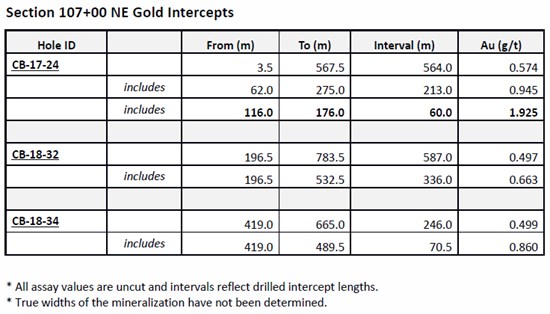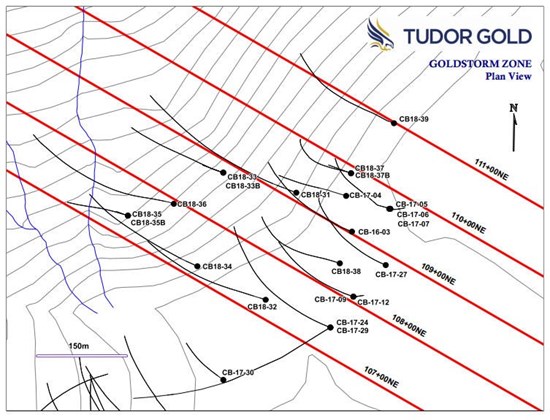
- Initial drilling expands the high-grade gold potential of the McKenzie Break deposit and intersects new structures at depth
- Highlights of initial results on the 13,945-metre 2018 diamond drilling program:
– Hole MK-18-196: 61.20 g/t Au over 2.6 metres, incl. 265.00 g/t Au over 0.6 metres
– Hole MK-18-183: 24.70 g/t Au over 0.6 metres
– Hole MK-18-180: 19.80 g/t Au over 0.4 metres
– Hole MK-18-195: 9.44 g/t Au over 2.0 metres, incl. 18.50 g/t Au over 1.0 metre
MONTREAL, Feb. 28, 2019 - MONARCH GOLD CORPORATION (“Monarch” or the “Corporation”) (TSX: MQR) (OTCMKTS: MRQRF) (FRANKFURT: MR7) is pleased to report the first assay results from the 2018 diamond drilling program at its wholly owned McKenzie Break gold project 25 kilometres north of Val-d’Or, near Monarchs’ Camflo and Beacon mills. The program started in September 2018 and ended in December 2018, with a total of 13,945 metres drilled in 61 holes. The purpose of the program was to explore below the known lenses and on the periphery of the multi-vein Green and Orange zones. Assays have been received for the first 21 holes totalling 4,424 metres of core (see table below for assay results).
“This first set of results attests to McKenzie Break’s solid exploration and high-grade potential, and already extends the deposit laterally and at depth,” said Jean-Marc Lacoste, President and Chief Executive Officer of Monarch. “Previous work on the property was mainly limited to the Green and Orange zones, which nonetheless enabled us to outline an indicated and inferred resource of over 165,000 ounces of gold (see press release dated June 14, 2018). Our aim going forward is to increase that resource.”
Hole MK-18-196 returned 61.20 g/t Au over 2.6 metres, including 265.00 g/t Au over 0.6 metres, at 260 metres below surface. This hole lies 110 metres west of a historic hole that returned 3.56 g/t Au over 1.1 metres, and 75 metres southeast of hole MK-18-195, which yielded 1.84 g/t Au over 1.0 metre. The intersections from holes MK-18-196 and MK-18-195 are on the same horizon, thereby potentially representing a new lens at depth.
Hole MK-18-183, drilled northwest of the proposed open pit, returned 24.70 g/t Au over 0.6 metres from a depth of 60 metres. Along with other holes drilled during the 2018 program, this positive result indicates the potential to extend the open pit towards the northwest.
Hole MK-18-180 returned a grade of 19.80 g/t Au over 0.4 metres from 90 metres below surface to the northeast of the Green Zone. This result extends the main Green Zone lens approximately 50 metres towards the northeast and will increase the underground mining resource in this area.
Hole MK-18-195 returned 9.44 g/t Au over 2.0 metres, including 18.50 g/t Au over 1.0 metre. This intersection is 195 metres below surface and represents a new lens below the main Orange Zone lens. The intersection lies approximately 80 metres northeast of the Orange Zone sector, with the nearest hole returning anomalous values 75 metres farther east. If connected, these results could enlarge the lens and extend it to the northeast.
Initial drill results for the McKenzie Break property:
| Hole | Length | From | To | Width* | Grade Au |
| number | (m) | (m) | (m) | (m) | (g/t) |
| MK-18-179 | 176 | 5.9 | 6.6 | 0.7 | 7.30 |
| 149.2 | 150.0 | 0.8 | 8.13 | ||
| MK-18-180 | 174 | 89.4 | 89.8 | 0.4 | 19.80 |
| 170.0 | 171.0 | 1.0 | 7.60 | ||
| MK-18-181 | 201 | 175.7 | 176.7 | 1.0 | 1.99 |
| MK-18-182 | 180 | 22.8 | 24.6 | 1.8 | 5.27 |
| MK-18-183 | 180 | 34.2 | 38.5 | 4.3 | 3.73 |
| Including | 37.5 | 38.5 | 1.0 | 7.43 | |
| 52.1 | 52.7 | 0.6 | 24.70 | ||
| 105.8 | 106.4 | 0.6 | 12.95 | ||
| MK-18-184 | 174 | 58.3 | 59.4 | 1.1 | 2.90 |
| 148.6 | 149.6 | 1.0 | 6.83 | ||
| MK-18-185 | 186 | 90.6 | 91.6 | 1.0 | 7.46 |
| 100.7 | 101.45 | 0.75 | 10.75 | ||
| MK-18-186 | 177 | 64.0 | 66.0 | 2.0 | 2.68 |
| MK-18-187 | 174 | 84.0 | 88.8 | 4.8 | 3.91 |
| MK-18-188 | 177 | 6.9 | 9.3 | 2.4 | 3.08 |
| 9.2 | 20.2 | 1.0 | 3.46 | ||
| 131.7 | 132.5 | 0.8 | 2.18 | ||
| MK-18-189 | 177 | 11.0 | 12.0 | 1.0 | 2.00 |
| MK-18-190 | 201 | 17.6 | 18.8 | 1.2 | 4.87 |
| 25.8 | 27.8 | 2.0 | 2.70 | ||
| 39.8 | 41.0 | 1.2 | 3.46 | ||
| MK-18-191 | 252 | 45.5 | 46.5 | 1.0 | 2.26 |
| 166.0 | 179.0 | 13.0 | 0.39 | ||
| MK-18-192 | 276 | 89.7 | 91.9 | 2.2 | 6.78 |
| 190.0 | 194.0 | 4.0 | 0.68 | ||
| 223.0 | 226.5 | 3.5 | 1.18 | ||
| MK-18-193 | 234 | 130.0 | 131.1 | 1.1 | 8.90 |
| 209.0 | 212.2 | 3.2 | 1.76 | ||
| MK-18-194 | 234 | 15.0 | 16.0 | 1.0 | 6.67 |
| 111.7 | 112.7 | 1.0 | 2.13 | ||
| MK-18-195 | 276 | 193.0 | 195.0 | 2.0 | 9.44 |
| Including | 194.0 | 195.0 | 1.0 | 18.50 | |
| MK-18-196 | 300 | 254.8 | 257.4 | 2.6 | 61.20 |
| Including | 255.7 | 256.3 | 0.6 | 265.00 | |
| 293.8 | 296.0 | 2.2 | 1.88 | ||
| MK-18-197 | 201 | 177.6 | 178.8 | 1.2 | 1.68 |
| MK-18-198 | 198 | 62.5 | 63.7 | 1.2 | 0.18 |
| MK-18-199 | 276 | 260.9 | 262.0 | 1.1 | 4.24 |
*The width shown is the core length. True width is estimated to be 90-100% of the core length.
McKenzie Break is a high-grade, multiple-narrow-vein gold deposit hosted in the dioritic Pascalis batholith and underlain by porphyritic diorite and mafic and felsic volcanic rocks. On June 14, 2018, the Corporation reported an NI 43-101 pit-constrained resource of 48,133 ounces in the Indicated category and 14,897 ounces in the Inferred category on the property, as well as an underground resource of 53,448 ounces in the Indicated category and 49,130 ounces in the Inferred category, for a total of 165,608 ounces of gold (Source: NI 43-101 Technical Report on the McKenzie Break Project, April 17, 2018, Alain-Jean Beauregard, P.Geo., and Daniel Gaudreault, Eng., of Geologica Groupe-Conseil Inc., and Christian D’Amours, P.Geo., of GeoPointCom Inc.).
Sampling normally consists of sawing the core into equal halves along its main axis and shipping one of the halves to the ALS Minerals laboratory in Val-d’Or, Quebec for assaying. The samples are crushed, pulverized and assayed by fire assay, with atomic absorption finish. Results exceeding 3.0 g/t Au are re-assayed using the gravity method, and samples containing visible gold grains are assayed using the metallic sieve method. Monarch uses a comprehensive QA/QC protocol, including the insertion of standards, blanks and duplicates.
The technical and scientific content of this press release has been reviewed and approved by Ronald G. Leber, P.Geo., the Corporation’s qualified person under National Instrument 43-101.
ABOUT MONARCH GOLD CORPORATION
Monarch Gold Corporation (TSX: MQR) is an emerging gold mining company focused on pursuing growth through its large portfolio of high-quality projects in the Abitibi mining camp in Quebec, Canada. The Corporation currently owns close to 300 km² of gold properties (see map), including the Wasamac deposit (measured and indicated resource of 2.6 million ounces of gold), the Beaufor Mine, the Croinor Gold (see video), McKenzie Break and Swanson advanced projects and the Camflo and Beacon mills, as well as other promising exploration projects. It also offers custom milling services out of its 1,600 tonne-per-day Camflo mill.
Forward-Looking Statements
The forward-looking
statements in this press release involve known and unknown risks,
uncertainties and other factors that may cause Monarch’s actual results,
performance and achievements to be materially different from the
results, performance or achievements expressed or implied therein.
Neither TSX nor its Regulation Services Provider (as that term is
defined in the policies of the TSX accepts responsibility for the
adequacy or accuracy of this press release.

View original content to download multimedia:http://www.prnewswire.com/news-releases/monarch-gold-intersects-61-20-gt-au-over-2-6-metres-including-265-00-gt-au-over-0-6-metres-at-its-mckenzie-break-gold-project-300804145.html
SOURCE Monarch Gold Corporation
















